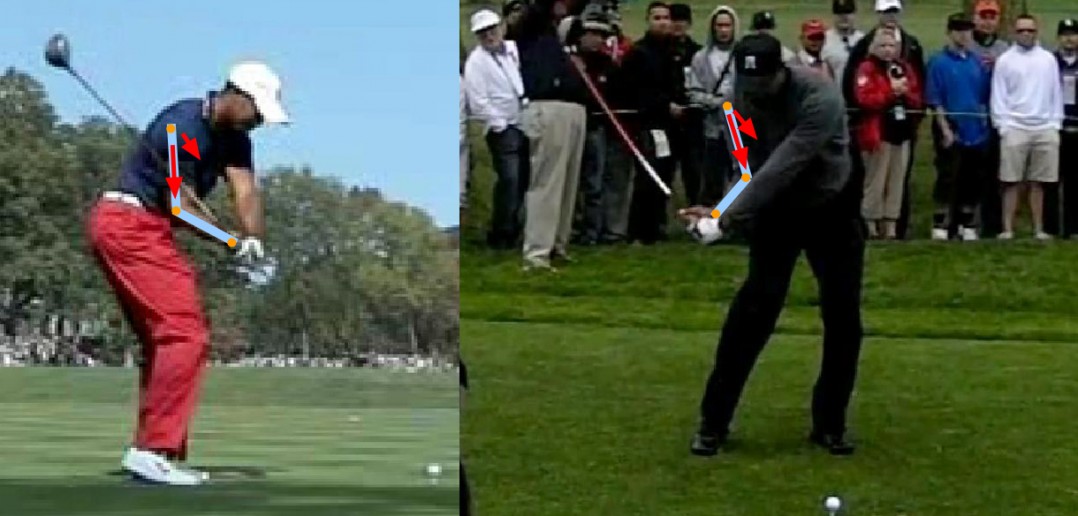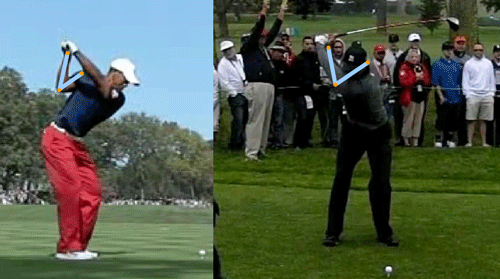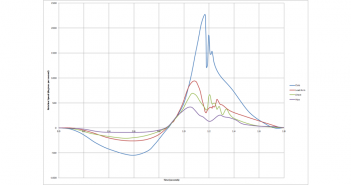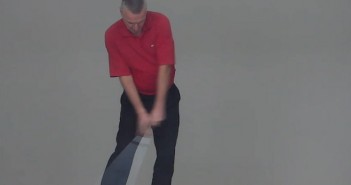In Golf Lag and the Compound Pendulum, we saw how power in the golf swing, in the form of club head speed, comes primarily from the correctly timed sequence of movements taking advantage of a simple mechanical phenomenon, the compound pendulum effect.
In this article, we take that discussion further by looking more closely at the role of the right arm in the golf downswing.
Once again, apologies to the lefties out there, but for simplicity these instructions are given for a right-handed golfer.
The right arm is often referred to by golf instructors as the “speed arm”, it has primary responsibility for transferring the energy from your torso through to the golf club, playing a crucial role in the golf swing kinematic sequence.
But the right arm isn’t simply used for energy transfer, it is also a compound pendulum in its own right, thus playing a complex role as a pendulum within a pendulum.
What’s more, the right arm amplifies the power generated by the torso as it transfers that power to the golf club. The muscles in the arm and chest pulling and straightening the arm during the downswing, building more energy, and then releasing that energy into the golf club at precisely the correct moment for maximum club head speed through impact.
The timing of the movements of the right arm, and the timing of the application of force by the muscles within, and connected to, the right arm during the downswing, are crucial for a great golf swing.
Most amateurs use their upper body far too much and far too early in the golf swing. This feels powerful, since your arms are connected to the golf club, but it prevents you from benefitting from the compound pendulum effect. It throws away all of the club head lag that could be used to generate Tour-calibre club head speed if the golfer would only learn to back off and apply power with their right arm much later in the downswing.
If the muscles are fired too early, then the arm will straighten too soon. This will disrupt the compound pendulum effect, resulting in a significant reduction in the energy that reaches the club head through impact. It will cause momentum to be “thrown out” into the golf club too early, resulting in “casting” of the club and a dramatic loss of speed and accuracy. Straightening the right elbow just 0.01 (one hundredth) of a second too early will result in a 10% loss of club head speed at impact.
Let’s take a look at how the right arm should move in the downswing:
Figure 1. Tiger Woods’ right arm downswing sequence.
In Figure 1, we can see Tiger Woods’ downswing sequence, both from face on and down the line, in slow motion. The blue lines and orange dots show the position of his right upper arm and forearm through the downswing. The red arrows indicate where muscular force is being applied by his pectoral muscles, deltoids, triceps, subscapularis, latissimus dorsi, and teres major, pulling his right arm down and across in front of his chest, and straightening it coming into impact.
The sequence begins at the end of the transition, his hips have already begun to turn towards the target, his weight has shifted over to his left side, and the club has just started to move back towards the ball.
There are a few key characteristics that you should note:
- The right arm stays bent at the elbow at approximately 90 degrees (the angle is distorted by the perspective of the two views), from the top until very late in the downswing — it doesn’t start to straighten until the hands reach about hip height.
- There is no conscious muscular effort applied to the right arm until the hands drop down to about waist height and the shoulders reach maximum rotational speed.
- The external rotation of the right arm (established at address and increased during the backswing) increases further as the right elbow starts down ahead of the hands, increasing the lag angles and stretching the shoulder. This also enables the deltoids to contribute energy to the golf swing.
- The elbow is pulled down and in front of the body just after the upper body starts to rotate hard. As the hands reach 9 o’clock (the left arm is horizontal), the right elbow is pointing towards the right toes.
- The right shoulder seems to “pause” as the right arm straightens, enabling (and due to) the transfer of energy from the core through to the arm.
- At the same time as the upper body rotation starts to decelerate, due to its energy transferring through to the right arm, the triceps fire to amplify the energy as the right arm straightens.
- Once the energy has been transferred away from the torso, the action of the right arm is far more passive than active — the arm behaves more like a whip than a piston, it has been driven by the body and is “cracking” through impact.
- By the time the hands reach 7:30, the right elbow is pointing directly at the left ankle, where it stalls as the right arm begins to straighten into the release.
- As the right arm starts to straighten, the right forearm is moving in the same plane as the golf club, pointing straight at the target line behind the golf ball.
- The golf club lags behind the hands as a natural consequence of how the body moves, there is no sense of “holding on” to the lag angle, rather it’s a case of moving correctly so as to not throw the lag away.
- The right forearm is pointing straight at the golf ball as the golf club lag is released into impact, and well ahead of the ball at impact.
- The right arm is still slightly bent through impact, straightening as he extends (is pulled) well into the follow-through as a result of efficient energy transfer.
It is very important to understand that there are two primary components at work in swinging the golf club: strength and mechanics.
The strength component must work in conjunction with the mechanical (compound pendulum) component primarily in the form of maintaining what is called “connection” during the transfer of energy (momentum) from the larger body parts (torso) to the arm.
In the sequence shown in Figure 1, if there was no force applied at all by the muscles of the right arm, other than that needed to stay connected, Tiger (or any elite golfer) would still generate far more club head speed than the average amateur.
Let’s say that again:
Just by moving correctly, and not applying any upper body strength, an elite golfer would still hit the ball further than the vast majority of amateur golfers.
Indeed, most amateur golfers apply their upper body strength in a very negative way. If the upper body is the primary mechanism for swinging the golf club, it results in a “disconnection”. This disconnection means that the right arm loses its ability to receive and transfer momentum away from the body through to the golf club. As a consequence, this disconnection forces the arm-shoulder complex to become more active than it should be for efficiently swinging a golf club. The over-use of the upper body forces the golfer to try and to make up for the lack of efficient transfer of momentum by “muscling” the golf club through impact, exacerbating the problem still further.
No matter how strong you are, you will generate far more club head speed as a result of a correctly timed sequence of movements than you can through muscular effort. Muscular effort can be beneficial, but only when applied carefully, at the right time and place, to supplement and enhance the mechanics of the golf swing. A great golf swing feels effortless compared to what most amateurs are used to.
Those of you who are good at pitching a baseball, or otherwise throwing balls, will have noticed the similarity in the movement of the right arm in Figure 1 with the mechanics of throwing. This analogy can be very useful, if you understand that efficient throwing is also core-driven, and not powered primarily by the right shoulder and arm. If you do understand this, then the movement of the right arm looks and feels the same as if you were trying to throw a ball, at hip height, towards the target. More of this in the downswing section of the Swing like a Champion system.
You may have noticed that we’ve not mentioned the muscles in the right forearm. That’s because, in a standard full swing from the tee or fairway, they don’t play much of a conscious role. The club head lag, seen as the angle between your right forearm and the golf club shaft, is released through impact as a consequence of the energy generated during the swing being transferred to the golf club, by proper mechanics rather than by muscular effort. The forearms and wrists should be as soft as possible throughout the downswing (other than wrist adduction), to enable the “whip to crack” — the forearms do not “muscle” the club through impact, as that would only slow the club head down.
The Swing like a Champion system will quickly teach you how to use your right arm as part of a Tour-calibre kinematic sequence in your own golf swing, generating more club head speed than ever before, with less effort, and less strain on your body.
If you have any questions or comments about this or other articles on Golf Loopy, please send us an email.
You May Also Like…
Introduction to the Swing like a Champion System
Overview of a Great Golf Swing, which summarises the correct movements in a great golf swing.
Golf Lag and the Compound Pendulum, which describes how you can use physics to generate more speed, accuracy and consistency in your golf swing, with less effort and less strain on your body.
An overview of the golf swing kinematic sequence, including a detailed analysis of the Downswing phase is presented in Golf Swing Sequence and Timing.
Golf Swing Sequence and Timing – Common Faults, which gives a comparison of the kinematic sequence for typical amateurs and Tour Pros, showing the common flaws that may plague your own golf swing.
Is the Golf Swing Powered by the Arms?
Why is Having the Shoulders “Connected” So Important? Which explains how the shoulders enable the power of the big muscles in your legs and core to be transferred to the golf club.
Golf Anatomy and Kinesiology, a collection of articles describing the roles of the muscles involved in the golf swing.
The Role of the Deltoids in the Golf Swing.
The Role of the Triceps in the Golf Swing.
Core muscles, which describes the muscles that run the length of your trunk and torso.
Internal and External Rotation, which describes the rotation of the right arm in the golf swing, and how to increase your range of motion.
Kinetic Chain, which describes how the different parts of your body act to transfer energy from the ground to the golf ball.





